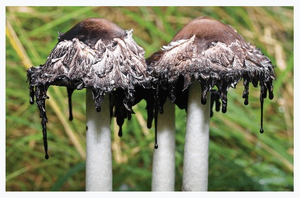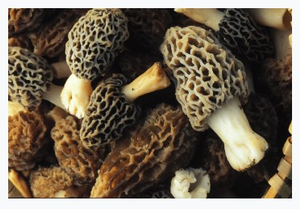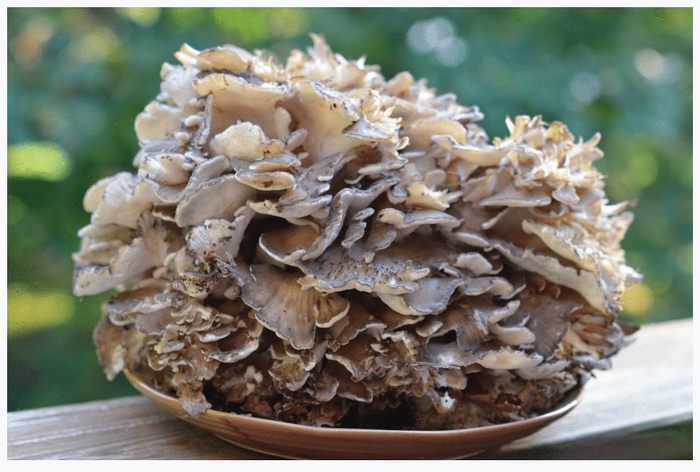 Wild or commercially grown, mushrooms
are a fascinating plant life. Packed with antioxidants, mushrooms will lend an
earthy, interesting flavor to everyday menus.
Wild or commercially grown, mushrooms
are a fascinating plant life. Packed with antioxidants, mushrooms will lend an
earthy, interesting flavor to everyday menus.
Many of us are intrigued by the odd growths, shapes, and fungal
arrangements that appear haphazardly around our yards, lawns, trees, and garden
beds. Over time, many fanciful explanations have been given for these
phenomena, such as the notion that they are the result of fairies dancing in rings,
sowing the seeds for future use as their homes.
Mushrooms are the visible
formations of certain types of fungi, although the inedible and poisonous
versions should be called toadstools to avoid confusion (especially for
children). While these fungal fruiting structures differ in size, shape and
color, the caps and stems are the main assembly, and microscopic pores form
under the caps.
Most mushrooms feed on
decaying organic matter thus the “rings” they form around food sources. The
growths will cease to appear once the food source is consumed. Removing and
discarding them is recommended to avoid any incidence of poisoning of pets or
children.
While only about 50,000
species have been described in North America,
the fungus kingdom is exceptionally diverse, and scientists believe that
millions may exist that are not yet identified. Most fungi in lawns are
beneficial since they decompose organic matter, releasing nutrients that are
essential to plant growth. As the fungi break down the organic matter, the
nutrients released provide essential fodder for lawns, garden plants, shrubs,
trees, and flowering plants.
Mushrooms are usually
harmless to grasses, but some consider them unsightly or want to eliminate them
because small children or pets may play in the area. Remove toadstools by
picking them out of the wood, trees or lawn patches as they appear and discard.
The use of a fungicide is not recommended as the application of these products
require multiple treatments at proper intervals over long periods of time.
Fungi are a fundamental
ingredient of all fertile soil. Fortunately, it is nearly impossible to
eradicate them. Therefore, when they pop up and fruit in your yard, remember,
they are a basic part of the life cycle. The
base structures of the mushroom are microscopic, but when nature calls, they
come together to form beautiful, complex patterns and configurations.
“Mushrooms are among the many un-numbered miracles of nature” so enjoy
their short-lived appearance. These fruiting constructions can survive for
years producing when conditions are most favorable such as periods of prolonged
wet weather.
Mushrooms display
themselves in many shapes, sizes and forms with interesting and clever
descriptive names that illustrate their diversity. Fairy Ring fungi present
themselves in circular or semi-circular rings that can range in size from one
inch up to twelve inches or more in diameter.
 Inky Cap mushrooms are a
common yet distinctive group and so named because the cap itself decomposes into
a dark liquid resembling ink shortly after its emergence. Puffball fungi are
named for the clouds of dust-like pores that are emitted when the mature body
bursts. True puffballs do not have a visible stalk or stem.
Inky Cap mushrooms are a
common yet distinctive group and so named because the cap itself decomposes into
a dark liquid resembling ink shortly after its emergence. Puffball fungi are
named for the clouds of dust-like pores that are emitted when the mature body
bursts. True puffballs do not have a visible stalk or stem.
Bird's nest mushrooms fruiting
bodies resemble tiny egg-filled nests. The stinkhorn mushroom is commonly seen
in the winter months, growing in piles of mulch or loose organic matter,
resembling a cluster of red/orange/brown/gray mottled eggs within the mulch.
Edible Mushrooms
Mushroom hunting can be dangerous. Learn from an
expert. If in doubt, throw them out
 Morel- harvest in spring, distinctive
“honeycomb” cap, deeply wrinkled, yellow-gray in color, strong taste, best
cooked in butter with leeks.
Morel- harvest in spring, distinctive
“honeycomb” cap, deeply wrinkled, yellow-gray in color, strong taste, best
cooked in butter with leeks.
Chanterelle- grow in clumps in late summer and early fall,
yellow or golden in color, funnel-shaped, meaty, may smell fruity, woody or
earthy. Chanterelles have a mild peppery taste. Cook with butter, wine, and
cream.
Fairy Ring- harvest in summer and fall, small mushrooms
that grow in a ring or arc, nipple-like cap in a pale tan or white color,
remove stem and rinse in cold water, use in more basic recipes to enjoy their
delicate flavor.
Hedgehog- harvest in summer and fall, defining
characteristics include spines or teeth on the undersides of the cap and pale
orangey tan in color, crunchy sweet nutty taste.
Shaggy
Mane / Lawyer’s Wig- June through November
(only edible when immature), a shaggy cap droops over the stem when young and
ready for consumption, a good addition to soups. Once the gills turn black they
are past their time.
Hen of
the Wood- perennial that
appears in the same place yearly in late summer and early fall for short
periods of time, tuber-like in large coral like clumps, caps are grayish brown
and are curled or spoon-like. Sauté in butter or olive oil.
Black
Trumpet- prefer damp and dark
areas for good growth in summer and fall (mainly in leaf litter which can make
them difficult to see), dark brown, black, or gray in
color in a trumpet shape with smooth texture overall. Rich smoky flavor,
delicious sautéed with garlic and oil.
Mushroom Facts
A single Portobello mushroom contains more potassium than a
banana.
Mushrooms are 90% water.
Mushrooms are known as the “meat” of the vegetable world.
One genus of mushrooms tastes like fried chicken (hen of the
wood).
Long before trees overtook the land, earth was covered by giant
mushrooms.
A 2,400-year-old giant “honey mushroom” in Oregon covers 2,200 acres and is thought to
be the largest living organism on the planet.
A three-pound white truffle mushroom once sold for $330,000.
Shitake mushrooms produce several crops when grown on sawdust or
grain. When grown on logs, fresh shitake mushrooms will develop every five
weeks for four to six years.
 A variety of mushroom-growing kits are available online or at
specialty garden nurseries.
A variety of mushroom-growing kits are available online or at
specialty garden nurseries.
Medicinal Properties of the Mushroom
Reduces systemic inflammation in muscles
and bones, gastrointestinal, and immune systems.
Helps to lower cholesterol.
A rich source of Vitamin D, copper and
zinc.
Regulates hormone and insulin production
to prevent diabetes.
Increases amounts of hemoglobin that
carries oxygen through the body.